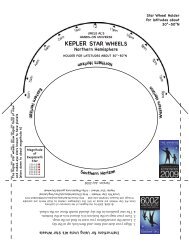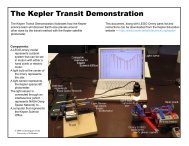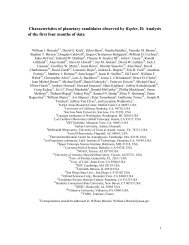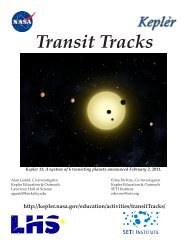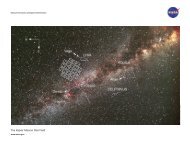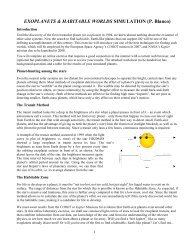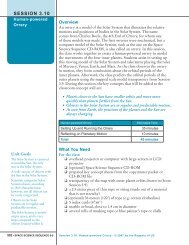Orbits of Jupiter's Moons - Kepler
Orbits of Jupiter's Moons - Kepler
Orbits of Jupiter's Moons - Kepler
You also want an ePaper? Increase the reach of your titles
YUMPU automatically turns print PDFs into web optimized ePapers that Google loves.
<strong>Orbits</strong> <strong>of</strong> Jupiter’s <strong>Moons</strong>Summary:Students use a series <strong>of</strong> 31 images <strong>of</strong> Jupiter’s 4 Galilean moons to find their orbitperiods and orbit radii. They compare their results with known data for those moons.Finally they test various mathematical expressions to find a “constant” relationshipbetween orbit period (T) and orbit radius (R) to arrive at <strong>Kepler</strong>’s 3rd Law.Materials:For each student:• 19-day Chart <strong>of</strong> Jupiter’s <strong>Moons</strong>• optional: colored pens or pencils, calculatorFor the Class• Jupiter-moon orbit demonstrator: paper plate with a bead or ball affixed to the rim,to represent a moon, and a pencil inserted through the center into a larger ball representingJupiter. The moon can be made to orbit Jupiter by rotating the pencil.Investigation Outline:1. Give each student a 19-day Chart <strong>of</strong> Jupiter’s <strong>Moons</strong>.Ask if they see any patterns in the chart.Jupiter-moon orbit demonstrator2. Let each student choose 1 moon to study, but make sure there are at least 3 studentsworking on any given moon. If they work in teams, they can be teams <strong>of</strong> 4 with eachteam member taking one <strong>of</strong> the numbered moons. Challenge students to find the period(T) and the orbit radius (R). Optional: to speed up the investigation have studentsstart with the 2nd Jupiter’s <strong>Moons</strong> worksheet that has moon 2 already drawn on it.CallistoGanymedeEuropaIo3. Once results are found, share them with team members or with the whole class.Compare to see if results are consistent.4. Have the students identifywhich moon is which using datafrom the the Internet or the table(right).5. Challenge students to find a“Constant” mathmatical relationshipbetween T and R. First givean example such as downloadinga song with N = number <strong>of</strong> kilobytes downloaded and T=time elapsed. Notice how N/T is constant (K), which wemight call the download speed.N(kilobytes)T(time)N/T100 kilobytes 0.5 sec 200 kilobytes/sec200 kilobytes 1.0 sec 200 kilobytes/sec500 kilobytes 2.5 sec 200 kilobytes/secN/T = K (constant) = 200 kilobytes/secPeriods <strong>of</strong>Galilean Satellites(in days)Io 1.77Europa 3.55Ganymede 7.15Callisto 16.76. Challenge students to find a formula (like N/T) thatwill result in a “Constant” relationship between period (P)and orbit radius (R) <strong>of</strong> Jupiter’s moons. Have them makea table like the kilobytes vs time table, but leave room formore columns to try out more ideas, in case P/R does notwork. What else could they try? P 2 /R, P 2 •R, P 3 /R 2 , P 2 /R 3 ,for example.7. The one that comes out constant is <strong>Kepler</strong>’s 3rd Law.Optional: Internet research on <strong>Kepler</strong> and his 3 laws thatgoven planetary motion.Point out that this constant allows us to predict how longit might take to download any given song or file. E.g. howlong would it take to download an 800 kb file?[T = N/K = 800kb/200kb/sec = 4 seconds] © 2009 by the Regents <strong>of</strong> the University <strong>of</strong> California
Jupiter’s <strong>Moons</strong>WorksheetNight #12345678910111213141516171819-2.0 -1.8 -1.6 -1.4 -1.2 -1.0 -0.8 -0.6 -0.4 -0.2 0 0.2 0.4 0.6 0.8 1.0 1.2 1.4 1.6 1.8 2.0 millions <strong>of</strong> km-2.0 -1.8 -1.6 -1.4 -1.2 -1.0 -0.8 -0.6 -0.4 -0.2 0 0.2 0.4 0.6 0.8 1.0 1.2 1.4 1.6 1.8 2.0 millions <strong>of</strong> km-2.0 -1.8 -1.6 -1.4 -1.2 -1.0 -0.8 -0.6 -0.4 -0.2 0 0.2 0.4 0.6 0.8 1.0 1.2 1.4 1.6 1.8 2.0 millions <strong>of</strong> km-2.0 -1.8 -1.6 -1.4 -1.2 -1.0 -0.8 -0.6 -0.4 -0.2 0 0.2 0.4 0.6 0.8 1.0 1.2 1.4 1.6 1.8 2.0 millions <strong>of</strong> km-2.0 -1.8 -1.6 -1.4 -1.2 -1.0 -0.8 -0.6 -0.4 -0.2 0 0.2 0.4 0.6 0.8 1.0 1.2 1.4 1.6 1.8 2.0 millions <strong>of</strong> km-2.0 -1.8 -1.6 -1.4 -1.2 -1.0 -0.8 -0.6 -0.4 -0.2 0 0.2 0.4 0.6 0.8 1.0 1.2 1.4 1.6 1.8 2.0 millions <strong>of</strong> km-2.0 -1.8 -1.6 -1.4 -1.2 -1.0 -0.8 -0.6 -0.4 -0.2 0 0.2 0.4 0.6 0.8 1.0 1.2 1.4 1.6 1.8 2.0 millions <strong>of</strong> kmGI-2.0 -1.8 -1.6 -1.4 -1.2 -1.0 -0.8 -0.6 -0.4 -0.2 0 0.2 0.4 0.6 0.8 1.0 1.2 1.4 1.6 1.8 2.0 millions <strong>of</strong> km-2.0 -1.8 -1.6 -1.4 -1.2 -1.0 -0.8 -0.6 -0.4 -0.2 0 0.2 0.4 0.6 0.8 1.0 1.2 1.4 1.6 1.8 2.0 millions <strong>of</strong> km-2.0 -1.8 -1.6 -1.4 -1.2 -1.0 -0.8 -0.6 -0.4 -0.2 0 0.2 0.4 0.6 0.8 1.0 1.2 1.4 1.6 1.8 2.0 millions <strong>of</strong> km-2.0 -1.8 -1.6 -1.4 -1.2 -1.0 -0.8 -0.6 -0.4 -0.2 0 0.2 0.4 0.6 0.8 1.0 1.2 1.4 1.6 1.8 2.0 millions <strong>of</strong> km-2.0 -1.8 -1.6 -1.4 -1.2 -1.0 -0.8 -0.6 -0.4 -0.2 0 0.2 0.4 0.6 0.8 1.0 1.2 1.4 1.6 1.8 2.0 millions <strong>of</strong> km-2.0 -1.8 -1.6 -1.4 -1.2 -1.0 -0.8 -0.6 -0.4 -0.2 0 0.2 0.4 0.6 0.8 1.0 1.2 1.4 1.6 1.8 2.0 millions <strong>of</strong> km-2.0 -1.8 -1.6 -1.4 -1.2 -1.0 -0.8 -0.6 -0.4 -0.2 0 0.2 0.4 0.6 0.8 1.0 1.2 1.4 1.6 1.8 2.0 millions <strong>of</strong> km-2.0 -1.8 -1.6 -1.4 -1.2 -1.0 -0.8 -0.6 -0.4 -0.2 0 0.2 0.4 0.6 0.8 1.0 1.2 1.4 1.6 1.8 2.0 millions <strong>of</strong> km-2.0 -1.8 -1.6 -1.4 -1.2 -1.0 -0.8 -0.6 -0.4 -0.2 0 0.2 0.4 0.6 0.8 1.0 1.2 1.4 1.6 1.8 2.0 millions <strong>of</strong> km-2.0 -1.8 -1.6 -1.4 -1.2 -1.0 -0.8 -0.6 -0.4 -0.2 0 0.2 0.4 0.6 0.8 1.0 1.2 1.4 1.6 1.8 2.0 millions <strong>of</strong> km-2.0 -1.8 -1.6 -1.4 -1.2 -1.0 -0.8 -0.6 -0.4 -0.2 0 0.2 0.4 0.6 0.8 1.0 1.2 1.4 1.6 1.8 2.0 millions <strong>of</strong> km-2.0 -1.8 -1.6 -1.4 -1.2 -1.0 -0.8 -0.6 -0.4 -0.2 0 0.2 0.4 0.6 0.8 1.0 1.2 1.4 1.6 1.8 2.0 millions <strong>of</strong> km© 2009 by the Regents <strong>of</strong> the University <strong>of</strong> California
Jupiter’s <strong>Moons</strong>WorksheetNight #12345678910111213141516171819-2.0 -1.8 -1.6 -1.4 -1.2 -1.0 -0.8 -0.6 -0.4 -0.2 0 0.2 0.4 0.6 0.8 1.0 1.2 1.4 1.6 1.8 2.0 millions <strong>of</strong> km-2.0 -1.8 -1.6 -1.4 -1.2 -1.0 -0.8 -0.6 -0.4 -0.2 0 0.2 0.4 0.6 0.8 1.0 1.2 1.4 1.6 1.8 2.0 millions <strong>of</strong> km-2.0 -1.8 -1.6 -1.4 -1.2 -1.0 -0.8 -0.6 -0.4 -0.2 0 0.2 0.4 0.6 0.8 1.0 1.2 1.4 1.6 1.8 2.0 millions <strong>of</strong> km-2.0 -1.8 -1.6 -1.4 -1.2 -1.0 -0.8 -0.6 -0.4 -0.2 0 0.2 0.4 0.6 0.8 1.0 1.2 1.4 1.6 1.8 2.0 millions <strong>of</strong> km-2.0 -1.8 -1.6 -1.4 -1.2 -1.0 -0.8 -0.6 -0.4 -0.2 0 0.2 0.4 0.6 0.8 1.0 1.2 1.4 1.6 1.8 2.0 millions <strong>of</strong> km-2.0 -1.8 -1.6 -1.4 -1.2 -1.0 -0.8 -0.6 -0.4 -0.2 0 0.2 0.4 0.6 0.8 1.0 1.2 1.4 1.6 1.8 2.0 millions <strong>of</strong> km-2.0 -1.8 -1.6 -1.4 -1.2 -1.0 -0.8 -0.6 -0.4 -0.2 0 0.2 0.4 0.6 0.8 1.0 1.2 1.4 1.6 1.8 2.0 millions <strong>of</strong> kmGI-2.0 -1.8 -1.6 -1.4 -1.2 -1.0 -0.8 -0.6 -0.4 -0.2 0 0.2 0.4 0.6 0.8 1.0 1.2 1.4 1.6 1.8 2.0 millions <strong>of</strong> km-2.0 -1.8 -1.6 -1.4 -1.2 -1.0 -0.8 -0.6 -0.4 -0.2 0 0.2 0.4 0.6 0.8 1.0 1.2 1.4 1.6 1.8 2.0 millions <strong>of</strong> km-2.0 -1.8 -1.6 -1.4 -1.2 -1.0 -0.8 -0.6 -0.4 -0.2 0 0.2 0.4 0.6 0.8 1.0 1.2 1.4 1.6 1.8 2.0 millions <strong>of</strong> km-2.0 -1.8 -1.6 -1.4 -1.2 -1.0 -0.8 -0.6 -0.4 -0.2 0 0.2 0.4 0.6 0.8 1.0 1.2 1.4 1.6 1.8 2.0 millions <strong>of</strong> km-2.0 -1.8 -1.6 -1.4 -1.2 -1.0 -0.8 -0.6 -0.4 -0.2 0 0.2 0.4 0.6 0.8 1.0 1.2 1.4 1.6 1.8 2.0 millions <strong>of</strong> km-2.0 -1.8 -1.6 -1.4 -1.2 -1.0 -0.8 -0.6 -0.4 -0.2 0 0.2 0.4 0.6 0.8 1.0 1.2 1.4 1.6 1.8 2.0 millions <strong>of</strong> km-2.0 -1.8 -1.6 -1.4 -1.2 -1.0 -0.8 -0.6 -0.4 -0.2 0 0.2 0.4 0.6 0.8 1.0 1.2 1.4 1.6 1.8 2.0 millions <strong>of</strong> km-2.0 -1.8 -1.6 -1.4 -1.2 -1.0 -0.8 -0.6 -0.4 -0.2 0 0.2 0.4 0.6 0.8 1.0 1.2 1.4 1.6 1.8 2.0 millions <strong>of</strong> km-2.0 -1.8 -1.6 -1.4 -1.2 -1.0 -0.8 -0.6 -0.4 -0.2 0 0.2 0.4 0.6 0.8 1.0 1.2 1.4 1.6 1.8 2.0 millions <strong>of</strong> km-2.0 -1.8 -1.6 -1.4 -1.2 -1.0 -0.8 -0.6 -0.4 -0.2 0 0.2 0.4 0.6 0.8 1.0 1.2 1.4 1.6 1.8 2.0 millions <strong>of</strong> km-2.0 -1.8 -1.6 -1.4 -1.2 -1.0 -0.8 -0.6 -0.4 -0.2 0 0.2 0.4 0.6 0.8 1.0 1.2 1.4 1.6 1.8 2.0 millions <strong>of</strong> km-2.0 -1.8 -1.6 -1.4 -1.2 -1.0 -0.8 -0.6 -0.4 -0.2 0 0.2 0.4 0.6 0.8 1.0 1.2 1.4 1.6 1.8 2.0 millions <strong>of</strong> km© 2009 by the Regents <strong>of</strong> the University <strong>of</strong> California
Worksheet: <strong>Kepler</strong>’s 3rd Law from the orbits <strong>of</strong> moons <strong>of</strong> JupiterMoon Io Europa Ganymede CallistoPeriod (P)Distance (R)P/RWrite an equation using P, R, and the Constant (K) that you found.Then calculate the distance from Jupiter <strong>of</strong> a newly discovered moonthat is found to have a period <strong>of</strong> 33 days.Worksheet: <strong>Kepler</strong>’s 3rd Law from the orbits <strong>of</strong> moons <strong>of</strong> JupiterMoon Io Europa Ganymede CallistoPeriod (P)Distance (R)P/RWrite an equation using P, R, and the Constant (K) that you found.Then calculate the distance from Jupiter <strong>of</strong> a newly discovered moonthat is found to have a period <strong>of</strong> 33 days.



